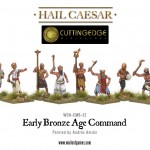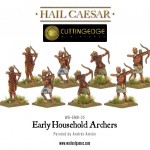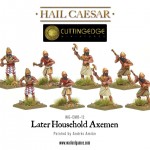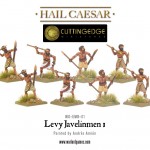Ancients wargaming expert Nigel Stillman provides a detailed account of Early Bronze age warfare. Part 3 examines the different troop types available to armies of the age. If you’ve not already done so, check out part one and part two first.
The Tactical Elements of an Army
Each powerful city-state, as well as the Akkadian kings, the Third Dynasty of Ur and outlying kingdoms such as Mari, Ebla and Elam, raised a variant of the same pattern of army, made up of similar tactical elements. In the Early Dynastic phase there may have been greater variation between the armies of different states, perhaps reflecting individual technical or tactical innovation. Strategic genius on the part of commanders such as Eannatum of Lagash or Sargon of Akkad must, at least in part, account for the victory of their cities over their rivals. Other cities may have been ultimately vanquished because their armies had been decimated by constant warfare, regardless of their strength or quality. From the evidence we can identify the troop types described below.
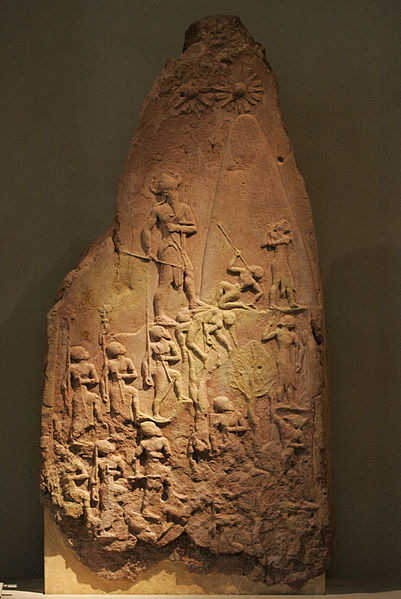
Household Troops – Royal Guard
The household troops of the Lugal, known as Shub Lugal or Aga Ush Lugal, formed the bodyguard of the king and the core of the army. I expect that this contingent would include the best of the main troop types in the army, especially foot guards with battle-axes, battle-carts and archers with composite bows. Elite soldiers usually had similar armour to leaders and commanders, such as the broad shoulder bands known later as tuttitu. From this inner core would be selected the unit commanders. Officers and commanders carried batons and ornate weapons as an insignia of rank, and they wore decorated helmets. Standard bearers were often priests.
Close Formation Infantry Spearmen
The infantry spearmen were known as Lu-Geshshuker or Lu-Geshgida after the long shukergallum spear (nicknamed ‘big needle’) and the Sumerian word for a spear, geshgid. They wore various kinds of armour. This seems to have been standardised within each city-state since it would be made in the state workshops. Armour would therefore have functioned as a distinctive uniform for the majority of the city-state’s soldiers. Spearmen of Ur wore a long, enveloping ‘war-cape’ studded with copper discs, leaving both hands free to hold a spear, and making a shield unnecessary. Lagash spearmen wore long fleecy kilts and shoulder bands, and at least the front rankers carried big rectangular shields with nine bosses, presumably copper. Akkadian spearmen, depicted carrying their long spears in the elbow at the ‘secure pike’ posture known from 17th Century European drill manuals, also wore long kilts and shoulder bands. All spearmen wore conical copper helmets rather like a medieval bascinet, and most carried a light axe as personal armament. Akkadian helmets, of which there were more designs, had leather aventails protecting the neck. In Akkadian and Third Dynasty Ur armies, huge ‘tower’ shield were still favoured and were made of reed or leather. Each soldier could have one hung from a shoulder strap, leaving both hands free to hold a long spear (as in near contemporary Minoan armies) or shields could be dispensed with in difficult terrain. Maybe the spearmen operated in a more open formation in these circumstances; relying only on their armour.
It is usually assumed that the spearmen were the majority troop type in most armies, including regular soldiers and militia, but since they were well equipped, and their formations required rudimentary drill and discipline as well as a stubborn unit coherency and determination in battle, it might be that they were a limited and precious contingent, rather like the hoplites of a small Greek city-state.
The records indicate that Sumerians had units of 60, 100 or 600 men, but the formation depicted on the Stele of the Vultures actually shows eleven soldiers, since the carving of the unit goes around the side as well as the front of the stela. There are actually more soldiers than you usually see in illustrations of this monument in books. Usually this is interpreted as a unit of 60 men plus an officer, but equally likely is that it depicts 60 spearmen as shown by the six pairs of arms gripping spears, and a front rank of 10 shield bearers walking in front of them. Since this would make a unit of 70 men, for which there are no references in documents, it might instead mean a unit of 100 men only 60 of which were spearmen, with 10 being shield bearers and the remaining 30 being skirmishers, or maybe axemen, archers and skirmishers in small detachments. More probably, and much simpler, would be to have a unit of 60 shield bearers who could deploy along the front of six units of spearmen. It is clear from the defensive armament, as well as the evidence for slings and archery, that the close formation troops had to try and make progress against a hail of missiles. Once most of the distance to the main enemy force had been covered, and their skirmishers swept away, the shield bearers could retire to the rear of the formation, or discard shields to fight with hand weapons or maybe retain their shields to assist in shoving and pushing the opposing enemy close formation troops. The Sumerian methods of organisation thus allowed for a lot of tactical variation and flexibility.
Infantry Battleaxe Men
Infantry axemen armed with battleaxes were known as Lu-Durtaba. The type of axe carried was called a Gamlu. It had a long handle with a curve at one end where the hefty crescentic blade was fitted. For those who wonder if axemen like this were really used, I refer you to the commander Lipet-Istar, who is recorded as sending out a force made up of equal numbers of spearmen, archers and axemen. Such axemen wore shoulderband armour and helmets, but are not shown with shields. Tucked into each soldier’s belt is a useful missile weapon: a pair of throwsticks known as a waspum or dalush, onomatapaic words for a hefty boomerang or throwing club. These were shaped aerodynamically to hurtle towards a foe at short range rather like a tomahawk. There are several ways in which axemen could be used tactically in battle; these are:
- To hack through the enemy line of shieldbearers.
- The hack off the long spear shafts of the enemy spearmen.
- To set upon stranded enemy battle-carts.
- To hack into the midst of the enemy formation to snatch the standard or strike down the leader.
- On campaign, to make a way through scrub for chariots and close formation troops.
- In siege-work, against gates and ladders, and against assault boats in actions on the Tigris or Euphrates.
Infantry Archers
Infantry archers were known has Lu-Geshban. These appear on the Stela commemorating the campaign of the Akkadian king Naram-Sin against the Lullubi tribe in the Zagros Mountains. They would have proven very useful on steep, wooded slopes against barely armoured foes armed with javelins or bows. Archers sometimes wore helmets and armour. An archer depicted in what may be a siege action found at Mari, is shown wearing a broad studded band over one shoulder. He is behind his commander who holds a huge, curved reed pavise, and is shooting at a high angle with a recurved composite bow. In battle against Umma in the fields of the Gu-Edina, Eannatum of Lagash was wounded by an arrow, which he heroically broke off and continued fighting.
Battle-carts – Early Chariotry
Chariotry, at this time being various designs of four or two wheeled battle-carts yoked to four wild asses, were known as Gishgigir. The two wheeled types, referred to as straddle and platform carts depending on whether the single crewman sat astride a saddle or stood on a platform, are often thought to be command vehicles. However, there is no reason why they might not be used just like the other battle-carts. The wheels of these vehicles are of solid wooden tripartite construction, with studded rims or leather tyres. The main feature is the upright cleft shield protecting the crew. The vehicle was probably constructed of wickerwork and a bent wood frame covered with leather. The four-wheeled battle-carts carried two crewmen, armed and armoured in the same way as elite soldiers. On the standard of Ur, a studded cape may be seen draped over the back of a battle-cart. The weaponry of the crew included a good supply of javelins carried in a quiver hung on the battle-cart, and a hefty mace or axe.
Battle-carts are shown charging, or rather pursuing, on the Standard of Ur. Each battle-cart is shown with the asses increasing their pace – from walk, to trot or canter and then to gallop. They trample fallen foemen while one crewman holds the reigns and the other hurls javelins. Asses are referred to frequently in records for pulling battle-carts and there were various types. It is thought that the wild asses, known as onagers, were rounded up on the Mesopotamian steppe (the Jazira) and harnessed to the battle-carts. It is also possible that mules, asses and possibly steppe ponies or small horses from Iran (the Anshe-zizi or Anshe kurru ‘foreign ass’) were used if available. The last of these are shown pulling the much later Elamite four-crew chariot. The ass team were protected by fabric or leather frontal armour.
Reconstructing the design of these chariots is greatly helped by looking at the many pottery and bronze models that have been found. These show in three dimensions what is often distorted by ancient efforts at perspective in two-dimensional scenes. Also, actual battle-carts have been excavated from burials at Kish and other sites, especially in the Caucasus region and the Eurasian steppes. These vehicles were in widespread use and appear on cylinder seals from Anatolia. The wheel types are known as far away as Europe. Many years ago a Sumerian chariot was reconstructed and tested as experimental archaeology for a television program. It was found to be reasonably fast, the asses were manageable and it had a wide turning arc.
Skirmishers and Light Troops
Skirmishers and light troops armed with slings, javelins and simple bows were probably provided by the conscripted militia. Finds of masses of sling stones at the site of a sacked city of the Uruk period, indicate that slings were important at least in siege warfare. The capes and big shields of the spearmen were intended to defend them from something. Probably this was missiles, and most likely a hail of sling-stones that they had to advance against. Sling-stones strike with much force, but Sumerian armour types would be effective. Skirmishers were likened to irritating swarms of stinging flies, gnats and insects.
Tribal Auxiliaries
Foreign auxiliaries included warriors from the nomadic Amorite tribes of the desert, known as Martu, that were living at this time in northern Mesopotamia and regions to the west. They were fierce and armed with a variety of weapons, as well as being skillful in tribal warfare, but they tended to be treacherous. A bodyguard of such troops, though useful and intimidating, might overthrow the king and put their own chieftain in charge. If a tribe was allowed to settle or graze their herds within the territory of a city-state, then the usual tribute, apart from animals, wool and hides, was to provide warriors for military service. Amorite troops were a major part of the army of Ebla. The Guti tribe of the Zagros Mountains also provided auxiliaries. Usually these were armed with bows, axes and javelins. A mercenary or allied contingent might be obtained from Elam, a much more civilised land that was governed from the city of Susa and ruled by Elamite kings or sometimes an Akkadian governor. Elamites could be a variant of any of the troops known from Mesopotamia, but the scanty evidence indicates armies included many archers armed with composite bows and wearing horned helmets. At this time, few of these tribal warriors used shields. Guti and Lullubi warriors wore a long hide robe fastened at one shoulder, rather like that worn by early Libyan warriors. Throwsticks were a favourite weapon of the Amorite nomad warriors and Gutian highlanders, in addition to short spears, bows, light axes, javelins, slings and daggers. Records from Ebla tell us that Amorites, being skilful metal smelters, made highly prized daggers and sickle swords.
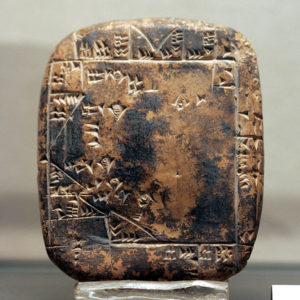
Allies
In the Early Dynastic period, the region around Kish and to the North was home to the Akkadians. It is often thought that the Akkadians made greater use of the composite bow than did the Sumerians, and this was exploited by Sargon to gain the upper hand over his rivals. Most evidence suggests that armies from Akkad and Kish, which lay within the same area, were organised just like those in Sumer. Perhaps they were stronger in battle-carts, since they might have better access to regions where the wild asses roamed. Far to the south, across the Persian Gulf but accessible also by marching overland, were the regions of Dilmun (Bahrain) and Magan. The Akkadian king Manishtushu conquered these lands. Here it ws possible to trade with merchants from the far away Indus civilisation, known as Melukhkha. The warriors encountered here lived in a copper-producing region, and were armed with spears and an early form of sword.
In the opposite direction, to the northwest, were the Hattian kingdoms, ancestors of the Hittites. Their armies included spearmen, axemen and battle-carts. Troy II was a mighty city at this time, but we know little of its military power as yet. The city of Ebla ruled a large area stretching across Upper Mesopotamia from Hamazi and Ashur in the east as far as Byblos and Canaan in the west. Ebla was a great rival of Mari. Eventually both cities would fall to the king of Akkad. Ebla recruited warriors from the Amorite tribes of this region, and sent a request to the allied city of Hamazi in distant Iran saying send me good mercenaries!
View our full Early Bronze Age range of models:

